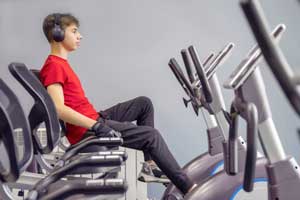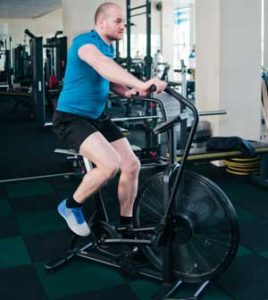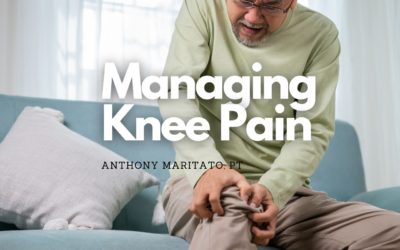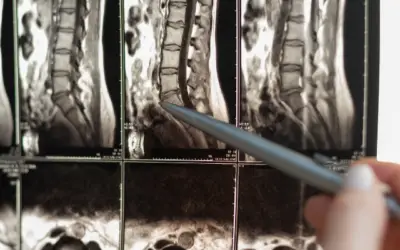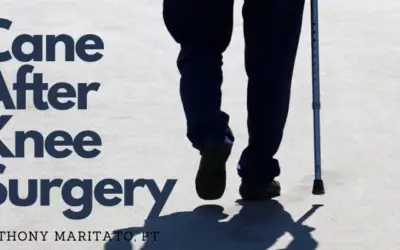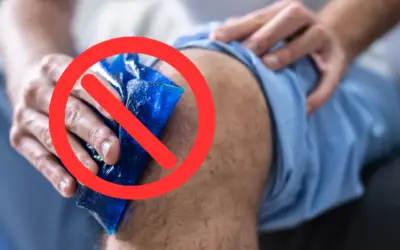How soon after knee replacement can I use exercise bike?
You can start using an exercise bike within the first 48-hours following a knee replacement surgery.
Standard practice in many physical therapy clinics is to begin using a recumbent bike with a gentle rocking motion until the knee is capable of a completing full rotation without significant pain.
When is it recommended to start using a stationary bike following a total knee replacement?
Immediately following the procedure a physical therapist will ensure the patient is safe to stand, walk, and move around the recovery room.
Many total knee replacements are performed on an outpatient basis and patients are discharged to home the same day.
A physical therapist or your surgeon may recommend you start using an exercise bike within 48-hours following surgery to keep the knee moving and reduce the chances of blood clots.
* Recommendation: when a stationary bike is used in the early recovery stages it is often recommended that the patient start with pedal rocks until the knee is capable of a full revolution without significant pain or compensation.
Phase 1 – Week 1 Post Op:
During the first week following knee replacement surgery a recumbent bike is often used to initiate joint motion.
Pedal rocks are an exercise used in which you place both feet on the pedals of the bike with the surgical knee foot on the lower pedal. You gently rock the pedals forward and back to initiate movement at the knee joint without significant pain.
Pedal rocks are performed for 3 to 5 minute episodes or as tolerated by the patient.
This exercise is usually performed 3 times a day if you have access to a recumbent or upright exercise bike at home.
As your range of motion improves you increase the size of the arcing motion until a full pedal revolution is achieved.
* TIP: Some patients prefer a reverse revolution at first until the knee range of motion has improved enough to complete a forward revolution.
Phase 2 – Week 2-4 Post Op:
As time on the exercise bike increases to 10-minutes the next phase would be to increase time walking and performing other exercises on your feet.
Once you can perform a 10-minute episode of pedaling on the exercise bike then spending more time performing weight bearing exercises are encouraged.
Some examples of weight bearing exercises include the following:
- Walking
- Elliptical Trainer
- Stairs
- Treadmill
- Stair Stepper
Phase 3 – Weeks 5-12 Post Op:
After 10-minutes of continuous cycling has been achieved, consider increasing the resistance and intensity of the time spent on an exercise bike.
Intensity may be varied by increasing the speed, moving the seat closer to the pedals to gain more range of motion, or increasing the resistance.
Interval training is another great option for increasing the intensity of time spent on an exercise bike.
A sample program may look like the following:
2-minutes warming up at a comfortable pace and seat position
2-minutes of 4 rounds of (10-seconds light resistance high speed | 20-seconds of light resistance low speed)
2-minutes of 4 rounds of (10-seconds high resistance low speed | 20-seconds of light resistance low speed)
2-minutes of high resistance low speed with a seat position close to the pedals
2-minutes cool down at a comfortable pace and seat position
What kind of stationary bike is recommended following a total knee replacement?
There are 4 common types of stationary bike:
1.) A recumbent bike – This is a bike that has a larger seat and back rest attached to the seat. The pedals are more forward and the seat level is closer to pedal level. See this post for more details >
2.) An upright bike – This bike has a smaller seat, no back support, and the seat is typically positioned above the pedals.
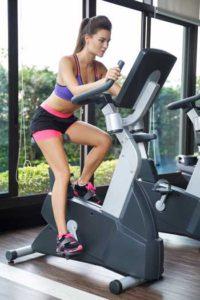
Upright-Stat-Bike-TKR-Rehab
3.) A fan bike – This is usually a version of an upright bike. It has arms that move in conjunction with the foot pedals and uses air resistance.
4.) Budget pedaler – This is a small, light weight pedal device that may be placed infront of a chair. The device is usually priced at less than $50. This device is often used for the lower body while sitting and the upper body while standing.
* Recommendation: when choosing any piece of exercise equipment the most important consideration is use… ‘Will You Use It?’
Buy something you will use. Buy something you will enjoy. Buy something that will improve your quality of life.
What if I cannot complete a full revolution on the pedals?
This video shares a simple strategy to start using a recumbent bike even if your knee flexion is limited.
* Recommendation: Unhook the strap on the pedal of your surgical side leg. Position your heel on the pedal on your surgical side leg while placing the ball of the foot on the center of the pedal on your non-surgical leg. Gently rock the pedals back and forth until you are able to complete a full revolution. Repeat the as the knee motion improves and move your seat slowly forward as tolerated.
What can I do to relax my thigh muscle?
A common report from patients is that the thigh muscle, the quadriceps, will tighten up as soon as they try to complete a full revolution on a bike.
That can happen for several reasons, but the most common is due to the body’s natural protective response. When something hurts or has the potential to hurt our body will tighten the muscles around a joint to prevent movement and prepare for pain.
One way to reduce this response is to massage the muscle. My favorite is a rolling pin massage. In this video you can see how a simple rolling pin from the kitchen will reduce pain, reduce guarding, and improve tissue mobility.
More Blog Posts …
Managing Pain After Total Knee Replacement
Introduction to Managing Pain After a Knee Replacement Undergoing a total knee replacement is a significant medical procedure that can dramatically improve your quality of life. However, the journey to full recovery involves navigating through various challenges, one...
Total Knee Replacement Pain at Night
What to Expect Explore our comprehensive guide on managing 'Total Knee Replacement Pain at Night.' Learn about the causes of night pain, effective pain management strategies, best sleeping positions, and more. This article provides practical advice to help individuals...
Overview of Spinal Stenosis
Table of Contents What is spinal stenosis What are the symptoms of spinal stenosis How is spinal stenosis diagnosed What are the different types of treatment for spinal stenosis Where to find more information 1. What is spinal stenosis Spinal stenosis is a condition...
Spinal Stenosis Exercises to Avoid: During Knee Replacement Recovery
Spinal stenosis is relatively common among adults having a total knee replacement surgery. While spinal stenosis doesn't always impact total knee replacement recovery, when it does, it can be frustrating. Before I specialized in treating patients after a total knee...
Ride a Peloton After Knee Replacement Surgery
Table of Contents When can I return to riding my Peloton bike at home after a total knee replacement? Is a Peloton bike good physical therapy after a total knee replacement surgery? Will riding my Peloton too much wear out my new knee? How often should I ride my...
How to Use a Cane After Knee Surgery
Table of Contents Understanding the Purpose of Using a Cane after Knee Surgery How to Properly Use a Cane after Knee Surgery Common Mistakes to Avoid When Using a Cane Transitioning from a Walker to a Cane: When and How? Understanding the Purpose of Using a Cane after...
Ice Machine for Knee Surgery
Table of Contents Benefits of Using an Ice Machine After Knee Surgery How an Ice Machine Works Top Ice Machines for Knee Surgery Recovery How to Use an Ice Machine After Knee Surgery Where to Buy an Ice Machine and What to Consider Benefits of Using an Ice Machine...
Walking Your Dog After Knee Replacement Surgery: A Timeline for Recovery
Table of Contents Introduction Walking Your Dog After Knee Replacement Safety Considerations and Precautions Conclusion Introduction Hello, fellow dog lovers and knee replacement warriors! I'm Anthony Maritato, a licensed physical therapist specializing in post-total...
Top 5 Mistakes After Knee Replacement
In this article I will share my experience as a physical therapist and personal trainer of more than 22 years treating patients after total knee replacement surgery. I have seen patients who made every mistake possible and still had a great outcome following this...
Disadvantages of Knee Replacement Surgery
Table of Contents Introduction Pain Time Lost Cost Stress Post Surgical Risk or Complications Conclusion Introduction When considering treatment options for severe knee arthritis, one commonly considered intervention is knee replacement surgery. Despite its high...
